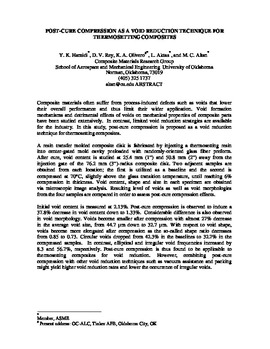| dc.contributor.author | Hamidi, Y. K. | |
| dc.contributor.author | Rey, D. V. | |
| dc.contributor.author | Olivero, K. A. | |
| dc.contributor.author | Aktas, L. | |
| dc.contributor.author | Altan, M. C. | |
| dc.date.accessioned | 2016-03-23T23:57:22Z | |
| dc.date.accessioned | 2016-03-30T15:36:21Z | |
| dc.date.available | 2016-03-23T23:57:22Z | |
| dc.date.available | 2016-03-30T15:36:21Z | |
| dc.date.issued | 2005 | |
| dc.identifier.citation | Hamidi, Y. K., Rey, D. V., Olivero, K. A., Aktas, L and Altan, M. C. Post-Cure Compression as a Void Reduction Technique for Thermosetting Composites, Presented at the 25th Oklahoma AIAA/ASME Symposium, 2005. | en_US |
| dc.identifier.uri | https://hdl.handle.net/11244/33183 | |
| dc.description.abstract | Composite materials often suffer from process-induced defects such as voids that lower their overall performance and thus limit their wider application. Void formation mechanisms and detrimental effects of voids on mechanical properties of composite parts have been studied extensively. In contrast, limited void reduction strategies are available for the industry. In this study, post-cure compression is proposed as a void reduction technique for thermosetting composites.
A resin transfer molded composite disk is fabricated by injecting a thermosetting resin into center-gated mold cavity preloaded with randomly-oriented glass fiber preform. After cure, void content is studied at 25.4 mm (1†) and 50.8 mm (2†) away from the injection gate of the 76.2 mm (3†)-radius composite disk. Two adjacent samples are obtained from each location; the first is utilized as a baseline and the second is compressed at 70°C, slightly above the glass transition temperature, until reaching 6% compression in thickness. Void content, shape and size in each specimen are obtained via microscopic image analysis. Resulting level of voids as well as void morphologies from the four samples are compared in order to assess post-cure compression effects.
Initial void content is measured at 2.13%. Post-cure compression is observed to induce a 37.8% decrease in void content down to 1.33%. Considerable difference is also observed in void morphology. Voids become smaller after compression with almost 27% decrease in the average void size, from 44.7 µm down to 32.7 µm. With respect to void shape, voids become more elongated after compression as the so-called shape ratio decreases from 0.85 to 0.73. Circular voids dropped from 42.3% in the baselines to 32.7% in the compressed samples. In contrast, elliptical and irregular void frequencies increased by 8.3 and 56.7%, respectively. Post-cure compression is thus found to be applicable to thermosetting composites for void reduction. However, combining post-cure compression with other void reduction techniques such as vacuum assistance and packing might yield higher void reduction rates and lower the occurrence of irregular voids. | en_US |
| dc.language | en_US | en_US |
| dc.title | Post-Cure Compression as a Void Reduction Technique for Thermosetting Composites | en_US |
| dc.type | Presentation | en_US |
| dc.description.peerreview | Yes | en_US |
| dc.description.peerreviewnotes | Peer reviewed and presented at the 25th Oklahoma AIAA/ASME Symposium. | en_US |
